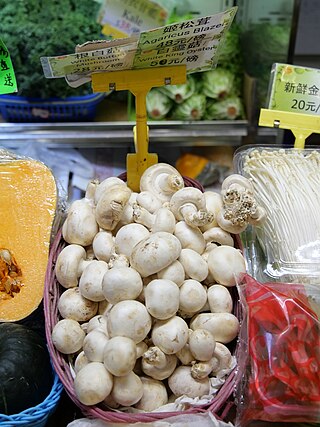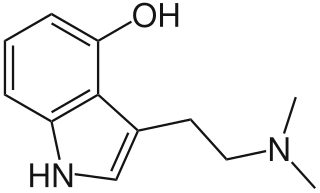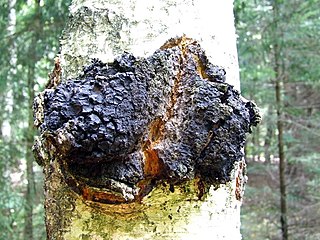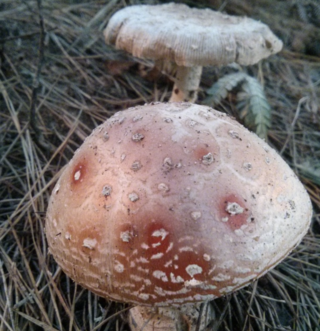
The shiitake is an edible mushroom native to East Asia, which is now cultivated and consumed around the globe. It is considered a medicinal mushroom in some forms of traditional medicine.

Edible mushrooms are the fleshy and edible fruit bodies of several species of macrofungi. They can appear either below ground (hypogeous) or above ground (epigeous) where they may be picked by hand. Edibility may be defined by criteria that include absence of poisonous effects on humans and desirable taste and aroma. Edible mushrooms are consumed for their nutritional and culinary value. Mushrooms, especially dried shiitake, are sources of umami flavor.

Psilocybin mushrooms, commonly known as magic mushrooms, are a polyphyletic informal group of fungi that contain psilocybin which turns into psilocin upon ingestion. Biological genera containing psilocybin mushrooms include Psilocybe, Panaeolus, Inocybe, Pluteus, Gymnopilus, and Pholiotina. Psilocybin mushrooms have been and continue to be used in indigenous New World cultures in religious, divinatory, or spiritual contexts. Psilocybin mushrooms are also used as recreational drugs. They may be depicted in Stone Age rock art in Africa and Europe but are most famously represented in the Pre-Columbian sculptures and glyphs seen throughout North, Central, and South America.

Matsutake, Tricholoma matsutake, is a species of choice edible mycorrhizal mushroom that grows in East Asia, Europe, and North America. It is prized in Japanese cuisine for its distinct spicy-aromatic odor.

Lingzhi, Ganoderma lingzhi, also known as reishi, is a polypore fungus native to East Asia belonging to the genus Ganoderma.

The Agaricaceae are a family of basidiomycete fungi and include the genus Agaricus, as well as basidiomycetes previously classified in the families Tulostomataceae, Lepiotaceae, and Lycoperdaceae.

Psilocin is a substituted tryptamine alkaloid and a serotonergic psychedelic substance. It is present in most psychedelic mushrooms together with its phosphorylated counterpart psilocybin. Psilocin is a Schedule I drug under the Convention on Psychotropic Substances. Acting on the 5-HT2A receptors, psilocin modulates the production and reuptake of serotonin. The mind-altering effects of psilocin are highly variable and subjective and resemble those of LSD and DMT.

Paul Edward Stamets is an American mycologist and entrepreneur who sells various mushroom products through his company. He is an author and advocate of medicinal fungi and mycoremediation.

Pleurotus ostreatus, the oyster mushroom, oyster fungus, hiratake, or pearl oyster mushroom is a common edible mushroom. It was first cultivated in Germany as a subsistence measure during World War I and is now grown commercially around the world for food. It is related to the similarly cultivated king oyster mushroom. Oyster mushrooms can also be used industrially for mycoremediation purposes.

Agaricus subrufescens is a species of mushroom, commonly known as almond mushroom, mushroom of the sun, God's mushroom, mushroom of life, royal sun agaricus, jisongrong, or himematsutake and by a number of other names. Agaricus subrufescens is edible, with a somewhat sweet taste and a fragrance of almonds.

Hericium erinaceus is an edible mushroom belonging to the tooth fungus group. Native to North America, Europe and Asia, it can be identified by its long spines, occurrence on hardwoods, and tendency to grow a single clump of dangling spines. The fruit bodies can be harvested for culinary use.

Inonotus obliquus, commonly called chaga, is a fungus in the family Hymenochaetaceae. It is parasitic on birch and other trees. The sterile conk is irregularly formed and resembles burnt charcoal. It is not the fruiting body of the fungus, but a sclerotium or mass of mycelium, mostly black because of a great amount of melanin. Some people consider chaga medicinal.

Laricifomes officinalis, also known as agarikon, eburiko, or the quinine conk, is a wood-decay fungus that causes brown heart rot on conifers native to Europe, Asia, and North America, as well as Morocco. The fungus is in the order Polyporales, as the fruiting bodies grow in large conks on the trunks of trees. Though it is nearly identical to Fomitopsis officinalis, DNA analysis supports L. officinalis as distinct from the genus Fomitopsis, however the names Laricifomes officinalis and Fomitopsis officinalis are generally used interchangeably.

Lentinus tigrinus is a mushroom in the Polyporaceae family. It is classified as nonpoisonous. It has been reported that mushrooms have significant antioxidant and antimicrobial activity.

Entoloma abortivum, commonly known as the aborted entoloma or shrimp of the woods, is an edible mushroom in the Entolomataceae family of fungi. Caution should be used in identifying the species before eating. First named Clitopilus abortivus by Miles Joseph Berkeley and Moses Ashley Curtis, it was given its current name by the Dutch mycologist Marinus Anton Donk in 1949.
Medicinal fungi are fungi that contain metabolites or can be induced to produce metabolites through biotechnology to develop prescription drugs. Compounds successfully developed into drugs or under research include antibiotics, anti-cancer drugs, cholesterol and ergosterol synthesis inhibitors, psychotropic drugs, immunosuppressants and fungicides.

Cerioporus is a genus of fungi in the family Polyporaceae. The type species is Cerioporus squamosus. Many species in Cerioporus were formerly placed in the genus Polyporus, however phylogenetic analysis shows that Cerioporus is a separate genus. It has been reported that mushrooms have significant antioxidant and antimicrobial activity.

Candolleomyces candolleanus is mushroom in the family Psathyrellaceae. It is commonly found growing in small groups around stumps and tree roots on lawns and pastures in Europe and North America. In 2014, it was reported from Iraq. The coloring varies between white and golden brown. The cap is tan when young, growing to 2–8 cm (1–3 in) in diameter, initially conical, later becoming rounded and finally with upturned margins in maturity. The cap margin is irregular and radially asymmetrical—a defining characteristic of this species. It can retain veil fragments on the edge and center. The white stalk is 4–10 cm (1.5–4 in) tall and 3–7 mm wide. The spore print is purple-brown, while spores are smooth and elliptical, measuring 6.5–8 by 4–5 µm. The specific epithet candolleanus honors Swiss botanist Augustin Pyramus de Candolle.

Amanita yema is a species of fungus in the genus Amanita, family Amanitaceae. The fungi can be identified by its pileus color of a red center that gradually fades into a yellow-hued edge. Growing only in forest outskirts in Mexico, the fungus is a critical member of the plant biome as it is a mycorrhizal fungi.

















